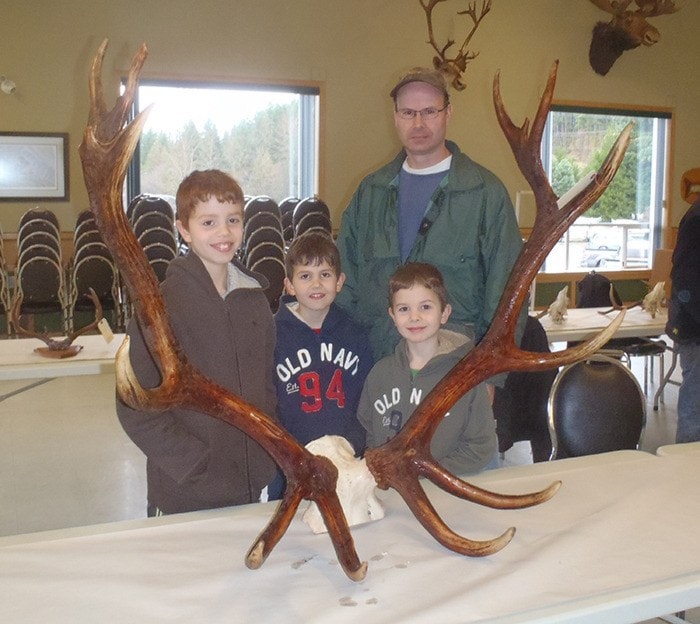The annual Antler Measuring Day is much more than a simple process of putting a tape on a set of antlers and coming up with a score that can be both exciting and disappointing for the person entering the antlers to be scored. It is a display of special animals taken in fair chase throughout the province.
This year there were some excellent black tail deer taken in the local hunting on Vancouver Island. There were also special antlers and horns such as a magnificent set of caribou antlers, some outstanding moose antlers, several sets of elk antlers and one set of large Rocky Mountain sheep horns.
Pictured with the column are Andy Flynn and his three young sons Owen, Seon and Thomas, posing with their father’s record book Roosevelt elk he took in a limited entry hunt on Vancouver Island. I suggest this family has the makings of a nature-oriented family with life-enriching connections to the outdoors as in hunting, fishing and nature study. It is also a good illustration of the positive family aspects of the Antler Measuring Day.
I wrote my first column on the Antler Measuring Day sponsored by the Courtenay and District Fish and Game Protective Association (CDFGPA) on Jan. 15, 1988. I do not believe I have missed a measuring day in the intervening 26 years. During that period I have come to look at the number of entries as an indicator of the abundance of our large ungulate big game animals such as moose, elk, mule deer, black tailed deer and white tailed deer throughout Vancouver Island and the mainland where much of our hunting takes place.
I have not looked at the more exotic species such as mountain sheep, goats, bison, bears, cougars, and wolves in the same context. Now I know this is probably not a valid scientific measure of abundance; but I cannot help but observe that the number of ungulate antler entries in the 2014 Antler Measuring Day event is about half of what it has been in previous years.
During the season I talked with several hunters who annually made extended trips to the Interior to hunt for moose, elk and deer. This year there were reports of extended trips into areas that the hunters were familiar and they came home without seeing an animal. Throughout much of the Interior (affected by the pine beetle plague), there appears to be notable decline of moose and mule deer numbers.
At the same time there was increased evidence of predation by timber wolves. The numbers of timber wolves in the record book has increased dramatically in the current season. Cougars also appear to be on the increase if reported sightings throughout Vancouver Island and elsewhere are a valid indicator of population increase.
Without getting carried away with wild assertions on what is happening to our big game populations, I would like to go on record as observing the decline in numbers of annual entries in the Antler Measuring Day may be an early indication of changing abundance in our big game populations of moose and deer. We are currently enjoying a winter of low snow accumulations and mild weather – maybe the situation will correct itself. In the meantime let’s hope the wolves do not eat themselves out of available venison.
Hunting, more than any other recreational activity, brings its participants into direct interaction with the natural rhythms of nature. You quickly become aware of changes in abundance of animals and birds in the areas you hunt. You also learn the condition of forage crops and the affects that weather has on them.
Droughts can change animal migration routes from one season to another. Hunting teaches you to constantly look at forage plants for signs of browsing and grazing by animals such as deer, elk and moose. You also learn the species of choice that each animal prefers. For example, elk tend to be grazers and eat grass much of the time, while moose are browsers and eat small tree branches most of the time. When you look at a moose it has long legs and a short neck, for browsing; while elk have shorter legs and long necks for eating low level plants.
Hunting is a natural human activity that does much to cure our nature deficit disorder created by spending too much time inside isolated from nature.
Ralph Shaw is a master fly fisherman who was awarded the Order of Canada in 1984 for his conservation efforts. In 20 years of writing a column in the Comox Valley Record it has won several awards.
